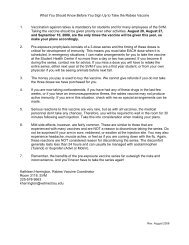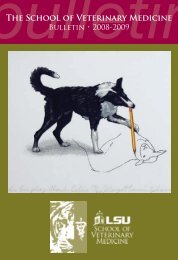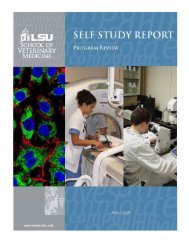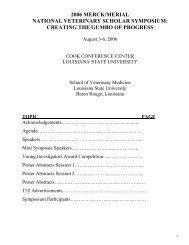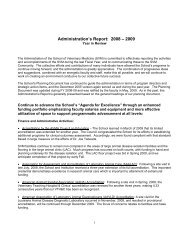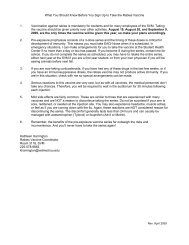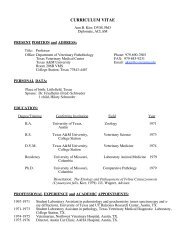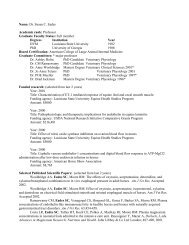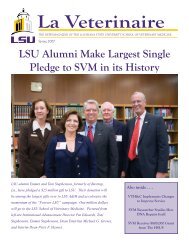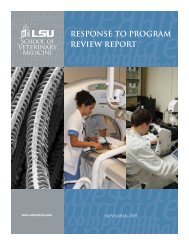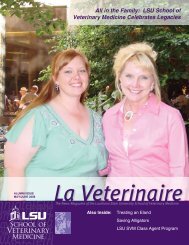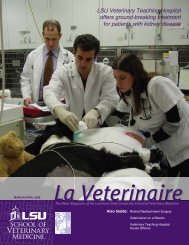Gimme Shelter - School of Veterinary Medicine - Louisiana State ...
Gimme Shelter - School of Veterinary Medicine - Louisiana State ...
Gimme Shelter - School of Veterinary Medicine - Louisiana State ...
Create successful ePaper yourself
Turn your PDF publications into a flip-book with our unique Google optimized e-Paper software.
La VeterinaireThe News-Magazine <strong>of</strong> the <strong>Louisiana</strong> <strong>State</strong> University <strong>School</strong> <strong>of</strong> <strong>Veterinary</strong> <strong>Medicine</strong>January/February 2008<strong>Gimme</strong> <strong>Shelter</strong>LSU SVM helps south <strong>Louisiana</strong> animalshelters while educating students
LSU <strong>School</strong> <strong>of</strong><strong>Veterinary</strong> <strong>Medicine</strong>AdministrationDr. Peter F. HaynesDeanDr. Thomas R. KleiAssociate Dean for Researchand Advanced StudiesDr. Joseph TaboadaAssociate Dean for Studentand Academic AffairsDr. David F. SeniorAssociate Dean forAdvancementand Strategic InitiativesErnie TanoosAssistant Dean for Financeand Administrative ServicesGinger GuttnerEditorKathleen HarringtonWriter and WebmasterNew FacultyDr. Xiaochu Wu washired as an instructor anddirector <strong>of</strong> the Microscopy Centerin the Department <strong>of</strong> ComparativeBiomedical Sciences effectiveSeptember 24, 2007. He received hisBS (Engineering) in Physics from EastChina Normal University in Shanghai,China, in 1987. Dr. Wu received hisfirst MS (Engineering) in MaterialDr. Xiaochu Wu Science from the Chinese Academy<strong>of</strong> Sciences in Shanghai in 1990 andhis second MS in Physics from York University in Toronto,Canada in 2002. He received a BS in Computer Science fromthe University <strong>of</strong> Saskatchewan in Saskatoon, Canada in 2004.In 2007, Dr. Wu received his PhD in Biomedical Engineeringfrom the University <strong>of</strong> Saskatchewan, where he also worked asthe manager <strong>of</strong> the university’s Microscopy Center. Dr. Wu’sresearch interest is how endogenously generated H_2 S by manycells and tissues in mammalian bodies may play physiologicalroles, such as neuromodulator and vasorelaxant in the biologicalsystem. As such, the precise measurement <strong>of</strong> the nano quantityand low concentration H_2 S in a mammalian body is Dr. Wu’sprimary interest.La Veterinaire is published bythe <strong>Louisiana</strong> <strong>State</strong> University,<strong>School</strong> <strong>of</strong> <strong>Veterinary</strong> <strong>Medicine</strong>,Office <strong>of</strong> Public Relations.Communications shouldbe addressed to Editor, LaVeterinaire, <strong>School</strong> <strong>of</strong> <strong>Veterinary</strong><strong>Medicine</strong>, <strong>Louisiana</strong> <strong>State</strong>University, Baton Rouge, LA70803, or sent via e-mail togguttner@vetmed.lsu.edu.Employment Opportunities at theLSU <strong>School</strong> <strong>of</strong> <strong>Veterinary</strong> <strong>Medicine</strong>For information on faculty and staffpositions at the LSU SVM, go to ourwebsite atwww.vetmed.lsu.edu/employment_opportunities.htm.La Veterinaire Jan/Feb 2008 3
The Dean’s CornerWelcome from the <strong>School</strong> <strong>of</strong> <strong>Veterinary</strong> <strong>Medicine</strong>.continues to prepare our graduates well for thewide range <strong>of</strong> career opportunities in veterinarymedicine. Graduates continue to distinguishthemselves and are a great point <strong>of</strong> pride for the<strong>School</strong>, including:Our program continues to be in transition aswe focus our efforts and resources on creatingan environment for success for our entire SVMcommunity and in support <strong>of</strong> the University’sNational Flagship Agenda. Our goals are sethigh, and we continue to work on securing thenecessary ingredients to make these a reality:hiring faculty scientists and clinical specialists<strong>of</strong> the highest quality; providing the requisiteinfrastructure including facility enhancementsand new technologies; and having a fundingportfolio that allows programmatic growth andcompetitiveness.• LSU-SVM graduates employed by Banfield,The Pet Hospital were again recognized in 2007for having the highest client satisfaction rating.• Dr. Mike Strain (LSU ‘83) was recentlyelected as the <strong>Louisiana</strong> Commissioner <strong>of</strong>Agriculture & Forestry.• Dr. Robert Simmons (LSU ‘77) was namedas a Distinguished Alumnus <strong>of</strong> the <strong>School</strong> signalinghis contributions and achievements as vicepresident for global pharmaceutical research forSchering-Plough Animal Health Corporation.Institutional Advancement, and fund-raising in The research program in the <strong>School</strong> continues toparticular, will become a clear priority for theprosper with two <strong>of</strong> our departments<strong>School</strong> to further enhance our programs. A key(Comparative Biomedical Sciences andplayer in this initiative will be Dr. David SeniorPathobiological Sciences) ranked in the top ten <strong>of</strong>who was recently named the associate dean for the University for research productivity. Areas <strong>of</strong>advancementexcellence that weand strategic initiatives. Fueledwill continue to focusby the generosity <strong>of</strong> aon include infectious$1,000,000 pledgedisease and cancerfrom Emmet andbiology researchToni Stephenson,with the centralwe will expand ourtheme <strong>of</strong>advancement teamcomparativeto further engagemedicine. Wesupporters andcontinue to recruitfriends <strong>of</strong> the <strong>School</strong>a director for theas we work to meetEquine Healthour Annual Fund andStudies ProgramCapital Campaignto continuegoals.the excellentDean Peter F. Haynes (right) with Lorraine Jones,interdisciplinaryOur pr<strong>of</strong>essionaladministrative coordinator, and Ernie Tanoos, assistantresearch done withininstructional program dean for finance and administrative services.that program.4 La Veterinaire Jan/Feb 2008
On the clinical and diagnostic fronts we continueto work on strategies that will enrich theeducational experiences <strong>of</strong> our pr<strong>of</strong>essional andpost-graduate students through an expandedcaseload. The shelter medicine programsupported by a grant from the Humane Society<strong>of</strong> the United <strong>State</strong>s and an expanded emergencyservice are two examples that have enhancedthe primary care experience for the students,improving their practice readiness upongraduation. Technological advances such asinterventional cardiac catheterization, magneticresonance imaging (anticipated for late spring <strong>of</strong>2008), and electroporation-assisted chemo-genetherapy for cancer will surely further enhance thereferral caseload.that you will join us on this journeyand look forward to any suggestions orcomments that you may have relativeto our service to the pr<strong>of</strong>ession and thepublic.From all <strong>of</strong> us at the <strong>School</strong>, we wish you the bestin this New Year.Peter F. Haynes, DeanThe capital outlay initiative to build the <strong>Louisiana</strong>Animal Disease Diagnostic Laboratory adjacent tothe <strong>School</strong> continues with the project bid target <strong>of</strong>June 2008. This facility will greatly improve theLaboratory’s functional capacity and fulfill some <strong>of</strong>the accreditation issues raised three years ago.The importance <strong>of</strong> communication cannot beoverstated, and I hope that you will stay in contactwith the <strong>School</strong> through our e-newsletter, theSVM Update. If you have not already done so, youcan sign up for the newsletter at www.vetmed.lsu.edu. You can also check the SVM website forinformative pieces, including the recently posted“Administration’s Report: 2005 – 2007, Two Yearsin Review” that provides much factual informationrelative to our progress/achievements on keyprograms and initiatives.Did You Know . . .The <strong>Veterinary</strong> <strong>Medicine</strong> Building willcelebrate its 30th anniversary in 2008.The building was <strong>of</strong>ficially dedicatedin October 1978, though the Class <strong>of</strong>1978 received special permission tohold its diploma distribution ceremonyin the SVM Auditoriumm in May 1978.The Class <strong>of</strong> 1982 was the first class tospend all four years in the <strong>Veterinary</strong><strong>Medicine</strong> Building.Finally, it was an honor to be named dean <strong>of</strong> our<strong>School</strong> <strong>of</strong> <strong>Veterinary</strong> <strong>Medicine</strong>, a responsibility thatI do not take lightly. My commitment, with theassistance <strong>of</strong> our fine administration, faculty, staff,and students, is to guide this strong program toincreased national prominence, competitiveness,and service to <strong>Louisiana</strong> and the region. I hopeLa Veterinaire Jan/Feb 2008 5
Clinical Case StudyLSU Performs Its First TranscatheterClosure <strong>of</strong> a PDA in a DogBentley, a six-year-old German Shepherd, came to theLSU <strong>School</strong> <strong>of</strong> <strong>Veterinary</strong> <strong>Medicine</strong> with congestiveheart failure. He was born with a congenital defectcalled patent ductus arteriosus (PDA), which isan abnormal persistence <strong>of</strong> a small blood vessel,the ductus arteriosus, between the aorta and thepulmonary artery, after birth. Bentley was treatedusing a procedure called transcatheter PDA occlusion.This is the first time this procedure has been done ona dog at LSU.“The ductus usually closes afterbirth,” said Dr. Romain Pariaut,assistant pr<strong>of</strong>essor <strong>of</strong> veterinarycardiology. “However, sometimesit doesn’t and can causecongestive heart failure ifleft untreated.” Bentleywas referred to the LSU<strong>Veterinary</strong> TeachingHospital after hisprimary veterinarian,Dr. Donna Kleinpeter(LSU SVM ’86),diagnosed him withheart failure. WhenBentley first arrivedat the LSU <strong>Veterinary</strong>Teaching Hospital,he was sufferingfrom pulmonaryedema (fluid in thelungs). Dr. Strickland,associate pr<strong>of</strong>essor <strong>of</strong>veterinary cardiology, and Dr.Dr. Romain Pariaut with Bentley.Pariaut diagnosed the PDA and discussed treatmentoptions with Bentley’s owners, Dr. Caroline Nash,an assistant pr<strong>of</strong>essor in the LSU French StudiesDepartment, and her husband, Peter Longerich.“We discussed the traditional surgical option, whichinvolves opening the chest cavity and ligating thevessel, and cardiac catheterization,” said Dr. Pariaut.“Using interventional cardiac catheterization is lessinvasive than surgery and does not require as muchrecovery time,” said Dr. Pariaut. A small incision ismade in the leg to gain access to the femoral artery.Then, a catheter is inserted into the femoral arteryand travels through the vessels to the heart. Theprocedure is done in radiologyusing fluoroscopy to track thecatheter’s path.The catheter includes a devicecalled an Amplatz® CanineDuctus Occluder (ACDO)manufactured by InfinitiMedical, LLC. The ACDO,which is made especiallyfor dogs, has a short waistseparating two disks that arereleased successively oncethe vessel is reached. Thefirst disk is released when itreaches the pulmonary artery.The second disk is deployedwithin the PDA to close thehole, which is now betweenthe two disks. The device isdetached from its delivery cable6 La Veterinaire Jan/Feb 2008
AoPDAPAA pigtail catheter is placed within the aorta and contrastsolution is injected. The contrast solution mixes with blood,following the blood path and highlights the vessels. Contrast isseen in the pulmonary vessels, indicating that a PDA is presentand connects the aorta with the pulmonary artery. Ao Aorta, PAPulmonary Artery, PDA Patent Ductus Arteriosus.and will remain in the body permanently, while thecatheter is removed.Johnson, the counselor,along with her intern, NatalieChandler, continuously providedme with updates during theprocedure, always maintaining a positiveattitude and <strong>of</strong>fering me words and gestures<strong>of</strong> comfort and encouragement. I will neverfind the words to adequately express mygratitude and praise to Bronk McDaniel, thestudent who was given charge <strong>of</strong> Bentley.He was extremely diligent, but aboveall, he went above and beyond his dutiesand responsibilities where Bentley wasconcerned. Lastly, I am deeply indebted toDr. Pariaut. First and foremost, one mustestablish a certain bond with a doctor whowill be performing a life-saving procedure,whether it be on you or your child. Further,it is critical that this bond be built on trust.Dr. Pariaut is a gift and a true blessing. LSUis extremely fortunate to have him on theirteam.”Bentley had the procedure on a Tuesdayand went home the next day, though he willbe on medication. “This procedure can beperformed in most <strong>of</strong> patients, but in toybreeds, the femoral artery may be too smallfor the catheter,” said Dr. Pariaut. “Bothcatheterization and surgery can successfullytreat PDA, and both options are <strong>of</strong>fered to theclients.” Because <strong>of</strong> the severity <strong>of</strong> his disease,Bentley will have to return to the <strong>Veterinary</strong>Teaching Hospital to check on his recovery andadapt his medications.AoHt“I cannot commend enough all who wereinvolved in saving Bentley’s life,” saidNash. “Dr. Strickland and Rachel Tankersley,cardiology assistant, played key roles during theprocedure in assisting Dr. Pariaut. StephanieThis image was obtained with fluoroscopy (Real-timeX-rays). It shows the Amplatz Canine Occluder device inplace in the ductus arteriosus. On the bottom left <strong>of</strong> theimage there is a 2-inch marker, that is used as a referencefor vessel size measurement. Ht: Heart, Ao: Aorta.La Veterinaire Jan/Feb 2008 7
<strong>Gimme</strong> <strong>Shelter</strong>Thousands <strong>of</strong> animals enter <strong>Louisiana</strong> shelterseach year. In response to the needs <strong>of</strong> some <strong>of</strong>these shelters and to expose veterinary studentsto a different aspect <strong>of</strong> veterinary medicine, theLSU <strong>School</strong> <strong>of</strong> <strong>Veterinary</strong> <strong>Medicine</strong> created aservice learning course, whereby an instructorand students visit shelters in south <strong>Louisiana</strong> tohelp with their medical needs. To help kick-startthe course, the SVM accepted a grant from theHumane Society <strong>of</strong> the United <strong>State</strong>s (HSUS).HSUS DonationIn December 2006, the Humane Society <strong>of</strong> theUnited <strong>State</strong>s pledged $800,000 to the LSU SVMto launch a community-based companion animalhealth program, including an active spay andneuter component, which gives students valuablemedical and surgical experience while providingassistance for animals in underserved communitiesin southern <strong>Louisiana</strong>. <strong>Shelter</strong>s participating inthe program are the <strong>Louisiana</strong> Society for thePrevention <strong>of</strong> Cruelty to Animals (Orleans Parish),the Jefferson Animal <strong>Shelter</strong> (Jefferson Parish, eastbank), the St. Bernard Parish Animal <strong>Shelter</strong>, PAWS(Plaquemines Parish), ARNO (Jefferson Parish), theDenham Springs Animal <strong>Shelter</strong> (Livingston Parish),and East Baton Rouge Parish Animal Control.The program began in July 2007, and somestudents began participating in the rotation in thesummer while they were technically on vacation.Official enrollment for credit began with the Fall2007 semester. Twenty-six students in the Class <strong>of</strong>2008 are enrolled in the fall and spring semesters.Thirty students in the Class <strong>of</strong> 2009 are currentlyscheduled to take the rotation during their senioryear. The students who took the rotation duringthe summer are Dr. Lacy Davis (intern), LaurenEsposito (Class <strong>of</strong> 2008), who took the rotationtwice; Verna Serra (Class <strong>of</strong> 2009), Jessica LetoSwanford (Class <strong>of</strong> 2008), Andrea Barros (Class<strong>of</strong> 2009), Kelly Minor (Ross student ), JaimeRodriguez (Ross student), Evan Sones (Class <strong>of</strong>2008), Tracy Millhouse (Class <strong>of</strong> 2008), HollyBrown (Class <strong>of</strong> 2010), and Layne Holland (Class <strong>of</strong>2008). From July through November 12, 2007, thenew shelter veterinarian, along with the studentsassisting, has done 818 health and wellness checks,164 spays, and 157 neuters.Jessica Enes (Class <strong>of</strong> 2008, right) and Dr. WendyWolfson (center) discuss a patient with Paula Neames,shelter manager, at the Denham Springs Animal <strong>Shelter</strong>.Service Learning CourseDr. Wendy Wolfson joined the faculty <strong>of</strong> theLSU SVM on May 1, 2007, as the new shelterveterinarian and as an instructor <strong>of</strong> veterinarysurgery. A 1986 graduate <strong>of</strong> the LSU SVM,Dr. Wolfson worked in shelter medicine for 218 La Veterinaire Jan/Feb 2008
years at the <strong>Louisiana</strong> SPCA in New Orleans,La. “After graduation, my interest was in largeanimal medicine, but I wanted to get some moreexperience in small animal medicine,” said Dr.Wolfson. “Also, I’m from New Orleans andwanted to spend more time with my family, so Itook the position with the SPCA and stayed.”Dr. Wolfson left the LASPCA to takethe position at the SVM. She and Dr. SusanEddlestone, assistant pr<strong>of</strong>essor, designed the servicelearning program aimed at teaching studentsprinciples <strong>of</strong> primary care veterinary medicine,basic surgery skills, and shelter medicine whilehelping <strong>Louisiana</strong> animal shelters. Dr. Wolfsonand the students visit each <strong>of</strong> the participatingsix shelters as part <strong>of</strong> a rotating schedule. “Thestudents and I visit the shelters four days a week,”said Dr. Wolfson. “We have a schedule for eachshelter, but we can adjust that schedule dependingon the needs <strong>of</strong> the shelters.”The shelter course began in July2007 with four students. “The rotationis a two week rotation with one t<strong>of</strong>our students enrolled at a time,” saidDr. Eddlestone. The students work in a differentshelter Monday through Thursday to assist Dr.Wolfson as she performs spays/castrations andwellness exams/medical care to shelter animals.“When we arrive at the shelter, we’re givena list <strong>of</strong> things they need, such as health exams,treating sick or injured animals or doing surgeries”said Dr. Wolfson. “Anything they need donemedically, we’ll do.” The students assist Dr.Wolfson, who goes over each case with them.On the way back to the SVM, they engage in adiscussion based on something the students sawor learned that day. “I’ve learned just as muchfrom them as they’ve learned from me,” said Dr.Wolfson. “I’ve learned something from everystudent. They’ve all added to my knowledge andDr. Wendy Wolfson (left) and Jessica Enes (Class <strong>of</strong> 2008)perform a spay on a cat at PAWS in Belle Chasse, La.La Veterinaire Jan/Feb 2008 9
keep me up-to-date.”Fridays are spent with the studentsin reflecting on the service learningaspects <strong>of</strong> what they did during theweek and on the impact that a veterinarian canhave in the community. Additionally, each studentprepares a presentation. The topic is based on aspecific problem learned about or encounteredduring the week. “Each student has to picktwo topics based on what they’ve seen duringthe week,” said Dr. Wolfson, “and they have toexpound on it. They have to teach me something Idon’t already know.”Lauren Esposito (Class <strong>of</strong> 2008) on the servicelearning curriculum:“The LSPCA was my first veterinary assistantjob. I witnessed plenty <strong>of</strong> depressing circumstanceswhile working at the LSPCA but also lots <strong>of</strong> happyendings. I believe it’s our job as veterinarians toensure that more happy endings occur. Beingactive in your local shelters, as well as promotingspay/neuters and preventative care, is an intrinsicpart <strong>of</strong> this.“When you only work in private clinics, youdon’t see this side <strong>of</strong> veterinary medicine. I hopethat people don’t walk away remembering only thedepressing circumstances that they saw but thatthe experience reaffirms why they are here in thefirst place. You may not be able to take in everyhomeless animal out there, but you can make surethat they have the best quality <strong>of</strong> life possible.“Every individual student will be affected ina different way by what he or she experiences onthis rotation, but no one will ever pass an animalshelter again without remembering what goes oninside them (both good and bad). That’s exactlyhow it should be.”Layne Holland (Class <strong>of</strong> 2008) on the servicelearning curriculum:“I decided to take the shelter medicine coursebecause I knew that many <strong>of</strong> the shelters in<strong>Louisiana</strong> are understaffed and have no residentveterinarian at their locations. I knew that therewould be many animals that needed our help.“It did not change my perception <strong>of</strong> howshelters operate because this is something that Ihave done research on in the past. I knew thateach shelter would be completely different andthat each one would operate in a totally differentmanner regarding staff members, euthanasiapolicies, vaccination protocols, etc.“It is definitely a great course to be <strong>of</strong>fered bythe LSU SVM. Besides the fact that we are singlehandedlyhelping so many <strong>of</strong> these shelters thatget no veterinary care, it shows students how much<strong>of</strong> a need there is for veterinarians to work andvolunteer at shelters.“I will definitely be volunteering at my localshelters in my free time. I also would considertaking a job as a shelter veterinarian.”Jessica Enes (Class <strong>of</strong> 2008) on the servicelearning curriculum:“I am extremely interested in a career inpublic health. The application <strong>of</strong> public health inshelter medicine is extremely apparent with themass quantities <strong>of</strong> animals, greater prevalence <strong>of</strong>unvaccinated animals, and increased prevalence <strong>of</strong>zoonotic disease. There is also the opportunity tounderstand population medicine and herd healthin the small animal setting. Understanding diseaseepidemiology and the need for isolation andquarantine are both extremely important aspects toall disciplines <strong>of</strong> veterinary medicine.“It has not really changed my perception <strong>of</strong>how shelters operate, but it has opened my eyesto the different types <strong>of</strong> shelters, such as no-kill,animal control, private and public, etc.“I really believe it is a wonderful course andthat all veterinarians should be aware <strong>of</strong> theshelters in their area and the efforts that mustcome together to keep them functional. Thecourse not only exposes you to different types <strong>of</strong>shelters but also allows students to see diseases invast numbers that private practitioners don’t evenget to see due to basic preventive medicine and10 La Veterinaire Jan/Feb 2008
asic health care. The different types <strong>of</strong> sheltersallowed me to understand what complications canoccur as a consequence <strong>of</strong> their set-up. It openedmy eyes to the importance <strong>of</strong> shelter design tocombat disease. It was also extremely interesting tobe able to apply a herd health mentality to smallcompanion animals. Every day was somethingdifferent, and our days were never boring.“This course will absolutely affect my careerpath. I am now determined to find local shelters inthe area where I decide to work and will volunteermy time or work part time. My interest in publichealth and population medicine are a perfect fit.I have also learned that the simplest proceduresyou can do for the animals can make an extremedifference in theirlives. Without thiscourse and theencouragement andguidance <strong>of</strong> Dr.Wendy Wolfson, Iwould have neverunderstood theimportance <strong>of</strong> beinginvolved in sheltermedicine. I am trulygrateful for her timeand the effort sheputs into trying toimprove the sheltersshe is involved with.Students assist volunteer veterinarians with spays and neuters aspart <strong>of</strong> the LSU-ASAP.She is truly committed to teaching us, and it reallyshows.”LSU-ASAPIn 2006, Dr. Eddlestone started the LSU AnimalSterilization Assistance Program (LSU-ASAP). Withthe help <strong>of</strong> a $40,000 grant from the KennethA. Scott Charitable Trust, $7,500 from NestléPurina, and the continuing support <strong>of</strong> the HSUS,the LSU SVM developed a monthly high-volumespay/neuter clinic to address the problem <strong>of</strong>overpopulation and to cut back on the euthanasiarate <strong>of</strong> healthy adoptable animals in the BatonRouge area. In conjunction with SpayBaton Rouge and other animal welfareorganizations, the LSU-ASAP performsapproximately 70-100 spay/neuters eachmonth on a Sunday, a volume <strong>of</strong> surgeries that iscurrently not possible at private veterinary clinics.Animals eligible for sterilization through theLSU-ASAP include feral cats as well as pets fromlow income families, local shelters, and humaneorganizations.Dr. Wolfson participates in the LSU-ASAPalong with students. Six to eight veterinarians fromthe SVM and the community participate alongwith the assistance <strong>of</strong> 25-30 students in performingspays and neuters <strong>of</strong> cats brought in by localorganizations whoare working withthe community.LSU-ASAP wasincorporated intothe HSUS programin January 2007. In2007, 424 spays and372 neuters wereperformed as part <strong>of</strong>the LSU-ASAP.“Thisprogram and thefew others like itin other veterinaryschools are bringingawareness to the specialty <strong>of</strong> <strong>Shelter</strong> <strong>Medicine</strong> inthe veterinary curriculum,” said Dr. Eddlestone.“<strong>Shelter</strong> <strong>Medicine</strong> throughout the country is nowbeing recognized with the respect it deserves. Aswe are finding in the students that have rotatedthrough our course already, many are interested inmanaging large numbers <strong>of</strong> animals rather than theindividual pet. <strong>Shelter</strong> <strong>Medicine</strong> is a challengingcareer that deals with many diverse issues thatdirectly impact communities and the care that theyprovide to their homeless animals.”La Veterinaire Jan/Feb 2008 11
A Moment in the History <strong>of</strong> <strong>Veterinary</strong> <strong>Medicine</strong>A Series by Dean Emeritus Everett D. BeschPrior to 1000 AD, scholars were schooled inchurch monasteries and nunneries. Individualswho craved education and could afford privatelessons were taught by clergy, lecturers orteachers that had no association with currenteducational institutions or were enrolled in churcheducational programs. As the eleven hundredsprogressed, two types <strong>of</strong> universities developed.One was the student-run pr<strong>of</strong>essional schoolformed by one <strong>of</strong> several student associationsthat set the standards for instructor qualifications,defined course content and set subject matter.The first <strong>of</strong> these institutions was the University<strong>of</strong> Bologna established in 1119 and was knownfor the study <strong>of</strong> law.Teachers or pr<strong>of</strong>essions, as they were known,formed their own association or guild and set therequirements for the examinations the studentshad to pass to earn degrees, established thequalifications for earning the title <strong>of</strong> teacher,and assessed fees for enrolled students. Thuswas developed the University <strong>of</strong> Paris in 1150.Cambridge University was established in 1209.Academic degrees evolved during the thirteenthcentury with a variety <strong>of</strong> titles, most meaning“teacher” or “learned man.” The term “doctor”(originally “teacher”) became the chief degree<strong>of</strong> faculties <strong>of</strong> law and medicine. By 1389, theUniversity Vienna approved an Act establishingthe degrees <strong>of</strong> the “Bachelor <strong>of</strong> the Arts,” “Master<strong>of</strong> Arts,” and “Doctor <strong>of</strong> <strong>Medicine</strong>, Law andTheology.”Since the early educational institutions wereestablished and maintained by the church, withthe sanction <strong>of</strong> the Pope, academic dress initiallyresembled the dress <strong>of</strong> the secular clergy. Thelay minority at the early universities began towear dress that was more individually designed.However, during the fifteenth century, academicdress began to take on a more formal designdetermined by academic degree and by theeducational institution.The following is part <strong>of</strong> the address by Dr. AlvinBertrand, Boyd Pr<strong>of</strong>essor Emeritus, LSU, duringthe “Hooding Ceremony” for the <strong>School</strong>’s 1988graduating class:“A hooding ceremony ‘...is an investiture <strong>of</strong>service...a rite <strong>of</strong> passage...the beginning <strong>of</strong>tomorrow.’ Participation in the ceremoniesassociated with graduation...proclaims to theworld that each student has fulfilled all therequirements appertaining to the particulardegree. In respect to veterinary medicine, it is acertification <strong>of</strong> the legitimacy or the right <strong>of</strong> thestudent to append D.V.M. after his or her name.”In respect to the same ceremony, the following isan excerpt <strong>of</strong> the address given by the Dean:“Academic regalia or academic costumeshave their origin in the early 11th century inEurope when the famous medieval universities<strong>of</strong> Bologna and Paris were founded alongwith Oxford and Cambridge in England. Thefirst universities were guilds or associations,sanctioned by the church, and with suchsanction, were free <strong>of</strong> the threat <strong>of</strong> royal orcivic interference. The student or scholar wasacknowledged, by licensure, <strong>of</strong> having completedthe qualifications <strong>of</strong> a full member, a Master <strong>of</strong>Arts, <strong>of</strong> the guild and, through his license, theMaster <strong>of</strong> Arts was admitted by his superiors to‘teach’ or to commence his ‘skill,’ his ‘trade’ or14 La Veterinaire Jan/Feb 2008
his ‘mystery.’ Thus, the term ‘Commencement’ isused for describing the ceremonies at the end <strong>of</strong>the academic training period and at the beginning<strong>of</strong> the new adventure.The gown is a holdover from the daily dress<strong>of</strong> Europeans in the 11th century. As fashionchanged with the years, academic costumeschanged slowly and eventually becametraditional. The style <strong>of</strong> today was established in1894 in the United <strong>State</strong>s by the IntercollegiateCommission. The Commission developed a codefor academiccostumes,includingdistinctivecolors andfeaturesfor the cap,gown andhoods forthe differentdegrees,fashionedafter theacademicpageantrymaintainedin Englishuniversities.The Class <strong>of</strong> 1988 in their regalia on the front steps <strong>of</strong> the LSU Unionon Commencement Day. This Class <strong>of</strong> 1988 will celebrate its 20thanniversary in 2008.Prior to the advent <strong>of</strong> synthetic fibers, the doctor’sgown was <strong>of</strong> black silk with full, round, opensleeves, faced with velvet and having three bars<strong>of</strong> velvet on each sleeve. Color <strong>of</strong> velvet forveterinary medicine is grey. The square cap,called a biretta, stems from the 16th century andclaims its style from the shape <strong>of</strong> books, or fromthe master workman’s mortar board or fromthe quadrangular shape <strong>of</strong> the English school’scampus. The tassel, or the tuft, is worn on top <strong>of</strong>the cap. The cap is worn to signify freedom andindependence, which has its origin from the rulethat freed slaves had the right to weara cap.The hood stems from the medievalcowl worn by monks and friars during the 11thand 12th centuries to cover and protect the headin inclement weather. The hood <strong>of</strong> the AmericanCode follows the Oxford shape and is wornby graduates <strong>of</strong> English speaking universitiesworldwide. The hood is black, about four feetin length and made with a wide panel edged invelvet the color <strong>of</strong> the field <strong>of</strong> study. Hoods arelined withsilk in the<strong>of</strong>ficialcolors <strong>of</strong> theinstitutionconferringthe degree.The hoodstands forqualificationandscholarshipin somebranch <strong>of</strong>study. AtLSU, theconferring<strong>of</strong> thedoctoral degree carries with it the right to wearthe hood that is distinctive for the degree. Forveterinary medicine, the hood is trimmed withgrey velvet and the lining shows the colors <strong>of</strong><strong>Louisiana</strong> <strong>State</strong> University and Agricultural andMechanical College.Since investiture means to establish in <strong>of</strong>fice, toratify or to confirm, the act <strong>of</strong> hooding candidatesfor the degree <strong>of</strong> the Doctor <strong>of</strong> <strong>Veterinary</strong><strong>Medicine</strong>, the faculty confirms and pr<strong>of</strong>essespublicly that each member <strong>of</strong> the class has met allqualifications for the degree.”La Veterinaire Jan/Feb 2008 15
Equine Emergency ServiceHandles Difficult Colic CaseThe 24-hour Emergency Service at LSU’s EquineHospital routinely performs surgery on emergencycolic cases over one hundred times a year. Colic, one<strong>of</strong> the leading causes <strong>of</strong> death in horses, is caused fromany number <strong>of</strong> issues having to do with problems inthe stomach, intestines, cecum or colon. Not all coliccases require surgery, but for many, surgery is the onlyoption for a successful outcome. Recently, a specificcase presented a unique challenge to the LSU team.Dr. Mustajab Mirza the emergency service veterinarianat LSU, along with equine surgery resident Dr. TimmGudehus, received a call one evening in early Januarywherein a 12-year-old Arabian gelding was beingreferred to the LSU Equine Hospital with a type <strong>of</strong>colic known as a cecum impaction. Upon initialexamination, the case immediately looked moretroublesome than a typical cecal impaction mightpresent, but upon rectal examination and sonographicevaluation, it was discovered to be an intussusceptionor “enveloping” <strong>of</strong> the small intestine, into the cecum.Approximately three meters <strong>of</strong> small intestine hadtelescoped into the cecum and was now non-viable.This along with a viable margins, a piece <strong>of</strong> smallintestine was resected in the cecum. It was stapledwith TA 90 and umbilical tape circumferentially.Performing a jejunocecostomy, Drs. Mirza andGudehus were able to reroute the small instestineand bypass the area into the cecum, rejoining livetissues and removing the deadened area <strong>of</strong> the gut aspreviously mentioned. This allowed for resumption<strong>of</strong> food material to use the cecum for fermentation andresume near normal life. No adhesions were noted, thesurgery was a success, and the horse went home withits owner.Colic cases vary so widely that there is no establishedmedical protocol that is guaranteed to work in everycase. Each case is evaluated individually and assessedfor the best possible course <strong>of</strong> action to return thehorse to a normal happy and healthy life.Dr. Mirza is a graduate <strong>of</strong> the University <strong>of</strong> <strong>Veterinary</strong>Sciences in Lahore,Pakistan, and later receivedhis Master’s degree andcompleted a residency inequine surgery at LSU.He is currently the headEmergency Equine Clinicianat LSU-SVM.Dr. Timm Gudehus is thecurrent resident in equinesurgery at LSU and receivedhis veterinary degree fromLutwig Maximillian’sUniversity in Germany.16 La Veterinaire Jan/Feb 2008
Looking Back at the SVM . . .The LSU SVM hosted its first Open House in 1982.The above photo was taken in the SVM Courtyardduring the 1986 Open House. On March 1 from 9:00a.m. to 4:00 p.m., the SVM will host its 26th OpenHouse. This event is free and open to the public.Information on these and other events is available atwww.vetmed.lsu.edu.The LSU SVM hosted its first Great Rover RoadRun in 1993. Pictured at left are (from left) Dr.Peter F. Haynes, now dean <strong>of</strong> the LSU SVM;Dr. Donald Lingard, now pr<strong>of</strong>essor emeritus <strong>of</strong>veterinary medicine and theriogenology; and Dr.Dennis McCurnin, former hospital director andnow pr<strong>of</strong>essor <strong>of</strong> veterinary surgery, at the 1994Great Rover Road Run. In years past, members <strong>of</strong>the faculty are responsible for”pooper scooping.”This year’s Run will take place on March 29. Preregistrationfor the 5K run and/or the one mile funrun/walk with rover is requested.The LSU SVM hosted the first International Exhibitionon Animals in Art in 1987. On March 29, the 21stexhibition will open with a reception in the SVMLibrary at 5:30 p.m. The exhibition will be on displayat the SVM through April 27. This event is also freeand open to the public.If you have photos <strong>of</strong> your time at theLSU SVM and would like to sharethem, please contact Ginger Guttner,coordinator <strong>of</strong>public relations, at 225-578-9922or gguttner@vetmed.lsu.edu.La Veterinaire Jan/Feb 2008 17
1977Dr. Allen Roussel wasnamed a de facto Diplomate in theEuropean College <strong>of</strong> Bovine HealthManagement. Allen is the onlyveterinarian from the United <strong>State</strong>sneither trained nor having practicedin Europe who earned acceptanceas a Diplomate in the College,which consists <strong>of</strong> 181 diplomatesrepresenting 25 countries. Allen isa pr<strong>of</strong>essor <strong>of</strong> large animal clinicalsciences at Texas A&M University’sCollege <strong>of</strong> <strong>Veterinary</strong> <strong>Medicine</strong>.Dr. Robert D. Lewis <strong>of</strong> Elgin, Texas,was recognized as an AmericanAssociation <strong>of</strong> Equine PractitionersDistinguished Life Member for hiscontributions to veterinary medicineand the AAEP at the December 4President’s Luncheon during theAAEP’s 53rd Annual Convention.1987Dr. Matt Welborn has switcheddepartments and is now in theDepartment <strong>of</strong> Comparative<strong>Medicine</strong> at the University <strong>of</strong>Alumni Tracks and Baby VetsTennessee College <strong>of</strong> <strong>Veterinary</strong><strong>Medicine</strong>. Matt is now concentratingmainly on public health. He is alsothe associate director for the Centerfor Agriculture and Food Securityand Preparedness at the university.He started these positions in July2007. Matt resides in Knoxville,Tenn.1990Dr. Kathryn McFadden is theowner <strong>of</strong> Towne South AnimalHospital in Shreveport, La.,which received accreditation fromthe American Animal HospitalAssociation in October 2007, makingit the only AAHA-certified hospitalin the area (the next closest certifiedhospital is in Carthage, Texas).1993Dr. Jennifer Beasley-McKean is thedistrict manager <strong>of</strong> the USDA FoodSafety Inspection Service in Dallas,Texas. She resides in Red Oak,Texas.Dr. Melburn G. Stephens is theIn MemoriamDr. Sandi Simoneaux Mottram (LSU ‘95) passed away on November11, 2007. She is survived by her husband Peter John Mottram and herdaughters Caitlyn Victoria Huff and Hannah Rose Mottram. Sandi is thedaughter <strong>of</strong> Clarence Simoneaux and the late Sandra F. Simoneaux. She isthe step-daughter <strong>of</strong> Lisa D. Simoneaux, granddaughter <strong>of</strong> Arthemise Faustand the late Michael Faust and Clarence and Dorothy Simoneaux. She isthe sister <strong>of</strong> Stacey S. Schmidt and the late Kimberly Ann Simoneaux andthe step-granddaughter <strong>of</strong> Beldren and Lucy Domangue. Sandi was 38years old. She was a native <strong>of</strong> New Orleans and a resident <strong>of</strong> Covington.Sandi received her DVM from the <strong>Louisiana</strong> <strong>State</strong> University <strong>School</strong> <strong>of</strong><strong>Veterinary</strong> <strong>Medicine</strong> in 1995. She was greatly loved and will be sadlymissed by all.area emergency coordinator forUSDA-APHIS-VS in Montgomery,Ala. He and his wife Sarah reside inDeatsville, Ala.1998Dr. Michelle L. (Berry) Purnellis a small animal internist forCarolina <strong>Veterinary</strong> Specialistsin Greensboro, N.C. Michellecompleted her residency in smallanimal internal medicine atOklahoma <strong>State</strong> University in 2001and moved to Greensboro, at whichtime she joined Carolina <strong>Veterinary</strong>Specialists. Michelle married DanPurnell in 2005, and they have onechild together, Andrew David, bornDecember 4, 2007,and she alsohas a stepson, Joseph (age 8). Shekeeps in touch with Shannon Stroupfrom her class, as well as KevinOppenheimer. Michelle hopes toattend the class’s 10th anniversaryreunion this year.2000Dr. Ashley Geoghegan opened anew mobile practice in Mandeville,La., called “Dr. G’s Mobile<strong>Veterinary</strong> Clinic.” The clinic<strong>of</strong>fers full service surgery,x-rays, dentals, blood work,examinations, lab work, allat your doorstep. The clinicwebsite address is www.drgmobilevet.com. Ashleyresides in Mandeville.2001 and 2002Drs. Matt Traylor (LSU ‘01)and Michelle Traylor (LSU‘02) had a baby girl namedReagan Lynn on October 19,2007. Reagan weighed 6 lbs.15 oz. and was 18 3/4 in. long.She is welcomed by big brother18 La Veterinaire Jan/Feb 2008
Alumni Tracks and Baby VetsReed, who turns three in February.Matt works for the USDA, andMichelle works in a small animalpractice. The Taylors reside inDubach, La.2003Dr. Raina Anne Perez is anassociate veterinarian at Safe HarborAnimal Hospital in Pensacola, Fla.She and her husband E.L. Fridgereside in Pensacola.2004Dr. Janine Antonia BarrettBradberry has worked at BanfieldCorp. in Jacksonville, Fla., since2005. She and her husband Kraigreside in Jacksonsville.Dr. Stacy H. Daigle and her husbandShane welcomed their second child,Emma Claire, on May 14, 2007.She weighed 6 lbs. 6 oz and was 18inches long. Their first daughterHanna just turned four. Stacy iscurrently doing relief work in theLafayette, La., area, and the familyresides in Churchpoint, La.Dr. Joey M. Landry and his wifehad their first child, Lacie Nicole, onSeptember 28, 2007. Lacie weighed6 lbs. 14 oz. The Landrys reside inNew Iberia, La.2005Dr. Erin McCarty Davezac and herhusband Boyd had a baby boy namedWilliam Patrick on August 10, 2007.William weighed 7 lbs. 11 oz. andwas 21 3/4 in. long. The Davezacsreside in Baton Rouge, La.2006Dr. Aimee L. Hocutt is a staffveterinarian at theAnimal EmergencyReferral Center in Torrance, Calif.She resides in Redondo Beach, Calif.Dr. Katrin Saile completed hersurgery internship at AuburnUniversity and has started hersurgery residency there. She andher husband Jim Rogers reside inAuburn, Ala.2007Dr. Marion R. (Lawrence) Sewellis an associate veterinarian at theRuston Animal Clinic in Ruston,La. Marion and her husband Lt. Col.G. Rowdy Sewell welcomed theirdaughter Rosemary Claire on August16, 2007. Rosemary weighed 6 lbs.9 oz. and was 21 in. long. Marionand her family reside in Ruston.LSU SVM Alumni:Please let us know how you are doing and what is going onin your life. Complete and return this form to us, or go tohttp://www.vetmed.lsu.edu, click on “Alumni & Donors”and then “Keep in Touch” under “Alumni Resources.”Name__________________________________________________Grad. Year_______________Address______________________________________________________________________________________________________________________________________________________________Home Phone________________ Work Phone_________________Email: _________________________________________________Mail to: Office <strong>of</strong> Public Relations<strong>School</strong> <strong>of</strong> <strong>Veterinary</strong> <strong>Medicine</strong><strong>Louisiana</strong> <strong>State</strong> UniversityBaton Rouge, LA 70803or send an e-mail to gguttner@vetmed.lsu.eduNews Item:__________________________________________________________________________________________________________________________________________________________________________________________________________________________________________________________________________________________________________________________________________________________________La Veterinaire Jan/Feb 2008 19
Class <strong>of</strong> 1977 Graduate ReceivesDistinguished Alumnus AwardThe LSU <strong>School</strong> <strong>of</strong> <strong>Veterinary</strong> <strong>Medicine</strong> awardedthe 2007 Distinguished Alumnus Award to Dr.Robert D. “Bob” Simmons (LSU ’77) at its 76thAnnual Conference for Veterinarians and <strong>Veterinary</strong>Technicians on November 10. Dr. Simmons is vicepresident, Global Pharmaceutical Research withSchering-Plough Animal Health Corporation inSummit, N.J. He was a member <strong>of</strong> the first class <strong>of</strong>the <strong>School</strong> <strong>of</strong> <strong>Veterinary</strong> <strong>Medicine</strong>, receiving his DVMfrom LSU in 1977. His class is celebrating its thirtiethreunion this year.Dr. Simmons joined Schering-Plough in 1988 asa research program director. He has served in hiscurrent position since 1997. After graduating fromthe SVM, Dr. Simmons first worked as a practicingveterinarian at Bossier Animal Hospital in BossierCity, La. From 1979 to 1988 he worked for BeechamLaboratories in Bristol, Tenn., before joining Schering-Plough. During his career with Schering-Plough,he has been involved in both pharmaceutical andbiological product development.As a vice president with Schering-Plough, Dr.Simmons is responsible for overseeing the researchand development <strong>of</strong> new pharmaceuticals for animalhealth. He is involved in all aspects <strong>of</strong>product development, from discoveryto clinical research and drug safety. Hehas been involved in the developmentand approval <strong>of</strong> many commonly usedproducts in veterinary medicinetoday, such as Clavamox®,Amoxi-Mast®, Mometamax®,Otomax®, Optimmune®,Orbax®, Zubrin®, Nuflor®,Banamine®, Resflor®,M+Pac®, Clinacox, Slice®and Aquaflor®. “Thesedrug introductions haveproven to be very importantcontributions to veterinarymedicine,” said Dr. StephenGaunt (LSU ’77), LSU SVMpr<strong>of</strong>essor <strong>of</strong> veterinary clinicalpathology, who nominated Dr.Simmons for this award.Dr. Simmons is a memberDean Peter F. Haynes (left) presents Dr. RobertD. “Bob” Simmons with the 2007 DistinguishedAlumnus Award at the LSU SVM’s 76th AnnualConference.<strong>of</strong> the American <strong>Veterinary</strong> Medical Associationand several other pr<strong>of</strong>essional organizations. He isa fellow in the American Academy <strong>of</strong> <strong>Veterinary</strong>Pharmacology and Therapeutics and is listed in Who’sWho in <strong>Veterinary</strong> <strong>Medicine</strong>. Dr. Simmons is alsoactive in the Bridgewater United Methodist Church,having served as the chairman <strong>of</strong> the Staff-ParishRelations Committee and as a youth advisor; he iscurrently a member <strong>of</strong> the Board <strong>of</strong> Trustees. Hehas served his community as Scoutmaster for BoyScout Troop 46 and is currently a staff member <strong>of</strong>Operation Shoebox NJ, a non-pr<strong>of</strong>it organization thatcollects, packs and ships items to our troops servingin Iraq, Afghanistan, and other Middle Easterncountries.Dr. Simmons met his wife Julia in 1976, whenshe presented her cat on an emergency call at theSVM. They married in 1979 and are the parents <strong>of</strong>two sons, Will (age 26) and John (age 22). “Bob is atthe height <strong>of</strong> an exemplary career, serving in a highlevelmanagement position in a worldwide player inthe veterinary pharmaceutical field,” said Dr. Gaunt.“LSU should be very proud <strong>of</strong> this alumnus!”Dr. Simmons was presented with the DistinguishedAlumnus Award by Dean Peter F. Haynes duringthe Alumni Luncheon at the LSU SVM’s AnnualConference on November 10. Uponreceiving the award, Dr. Simmonsstated, “I would like to thank the<strong>School</strong> <strong>of</strong> <strong>Veterinary</strong> <strong>Medicine</strong> forpresenting me with thiswonderful honor and forthe instruction that theClass <strong>of</strong> 1977 received,which enabled us togo on and accomplishthe things that wehave achieved. Myappreciation goes out tothe <strong>School</strong> <strong>of</strong> <strong>Veterinary</strong><strong>Medicine</strong>, the staff—some<strong>of</strong> whom are still heretoday—to the Class <strong>of</strong>1977, and to my bestfriend, who is also mywife, Julia.”20 La Veterinaire Jan/Feb 2008
Advance <strong>Veterinary</strong> <strong>Medicine</strong>Fund Vital to SVM’s FutureEach year a new class enters the <strong>School</strong> <strong>of</strong> “It has become increasingly apparent over time<strong>Veterinary</strong> <strong>Medicine</strong> and another class leaves the that the future <strong>of</strong> unique value-added initiativesnest. A student’s time at the <strong>School</strong> is chronicled in the <strong>School</strong> <strong>of</strong> <strong>Veterinary</strong> <strong>Medicine</strong> will relyby perseverance, hard work, camaraderie and primarily on private donors who believe that ourlasting friendships, not only with fellow students programs are highly valued by the broad societybut with faculty and staff as well. “Each success that we serve,” said Dean Peter F. Haynes.achieved by one <strong>of</strong> our graduates is a success forthe <strong>School</strong>,” said Dr. David F. Senior, associate With dwindling state and federal support, publicdean for advancement and strategic initiatives. institutions are relying more and more on private“We want our graduates to be proud <strong>of</strong> the funds. “To improve the quality <strong>of</strong> our education,education they have received, just as we are proud research and service missions, we must rely on<strong>of</strong> all <strong>of</strong> them.”private donors,” said Edwards. “The Advance<strong>Veterinary</strong> <strong>Medicine</strong> Fund was established toIn addition to students and alumni who have a provide the lifeblood for the <strong>School</strong>. It is a generalconnection to the <strong>School</strong> <strong>of</strong> <strong>Veterinary</strong> <strong>Medicine</strong>, support fund that the Dean utilizes for the greatesclients who bring their animals to the <strong>Veterinary</strong> need <strong>of</strong> the <strong>School</strong>.”Teaching Hospital also become a part <strong>of</strong> the SVMfamily. “It is through these connections that the Your gift to the Advance <strong>Veterinary</strong> <strong>Medicine</strong><strong>School</strong> will continue to play a vital role in the Fund will contribute to the success <strong>of</strong> ourfuture <strong>of</strong> veterinary medicine,” said Pat Edwards, graduates and help ensure the quality <strong>of</strong> educationdirector <strong>of</strong> institutional advancement.for future veterinarians.AKC Donates Funds for Mobile Emergency Response UnitThe American Kennel Club Companion Animal Recovery Canine Support and Relief Fundcontributed $100,000 in support <strong>of</strong> a mobile Emergency Response Unit, which has beenordered. The LSU <strong>School</strong> <strong>of</strong> <strong>Veterinary</strong> <strong>Medicine</strong> expects to get the unit by late spring/early summer. The unit is built for spays/castrations and as an emergency medical mobilein disasters. It will be used for disasters if they occur, and it will be taken once a week toanimal shelters that have no surgical facilities so that spays/castrations can be performed aspart <strong>of</strong> the service learning course with Dr. Wendy Wolfson (see story on page 8).La Veterinaire Jan/Feb 2008 21
Advance <strong>Veterinary</strong> <strong>Medicine</strong> Fund Gift Club LevelsThe annual Advance <strong>Veterinary</strong> <strong>Medicine</strong> Fund is the cornerstone <strong>of</strong> advancement for the<strong>School</strong> <strong>of</strong> <strong>Veterinary</strong> <strong>Medicine</strong>. The <strong>School</strong>’s long-term strategic plan sets progressivegoals and objectives that will advance veterinary medicine regionally and internationally. These highstandards can only be met through private sector donations to subsidize dwindling state appropriations.The future <strong>of</strong> the <strong>School</strong> is dependent upon the Annual Fund.Dr. Daniel J. HillmannClub ($100-$499)Donors who make anannual gift that is between$100.00-$499.00 arerecognized as members <strong>of</strong>the Dr. Daniel J. HillmannClub. In 1973, Dr.Hillmann was one <strong>of</strong> thefirst faculty members appointed to the LSU <strong>School</strong><strong>of</strong> <strong>Veterinary</strong> <strong>Medicine</strong>, and he continues to teachanatomy to our veterinary students today. Duringthis time, he has touched the lives <strong>of</strong> each one <strong>of</strong>our graduates, earning their respect as NordenTeacher <strong>of</strong> the Year on many occasions.Dr. John D. Rhoades Club($500-$999)Donors who make anannual gift that is between$500.00-$999.00 arerecognized as members <strong>of</strong>the Dr. John D. RhoadesClub. Dr. Rhoades wason the faculty <strong>of</strong> the LSU<strong>School</strong> <strong>of</strong> <strong>Veterinary</strong> <strong>Medicine</strong> from 1980-2005,and as Associate Dean <strong>of</strong> Student Affairs hetouched the lives <strong>of</strong> every veterinary studentduring that time. He provided both pr<strong>of</strong>essionalguidance and “fatherly” advice from the timethe students applied to veterinary school untiltheir graduation. Even after his retirement, hehas enjoyed remaining in contact with alumni atpr<strong>of</strong>essional veterinary conferences.Dr. William L. JenkinsSociety ($1,000-$2,499)Donors who make anannual gift that is between$1,000.00-$2,499.00 arerecognized as members <strong>of</strong>the Dr. William L. JenkinsSociety. In 1988, Dr.Jenkins was appointed thesecond Dean <strong>of</strong> the LSU <strong>School</strong> <strong>of</strong> <strong>Veterinary</strong><strong>Medicine</strong>. He has had an extraordinary careerat LSU, moving into the positions <strong>of</strong> ExecutiveVice Chancellor and Provost, then Chancellor <strong>of</strong>the LSU and A&M College, and finally President<strong>of</strong> the LSU System. Dr. Jenkins has been a trueinspiration to many <strong>of</strong> our veterinary students,faculty and colleagues.Giving a Gift to the SVMTo make a contribution to the <strong>School</strong> <strong>of</strong><strong>Veterinary</strong> <strong>Medicine</strong>, please visitwww.vetmed.lsu.eduand click on “Support the LSU SVM.,”use the form included in this publication orcontact Pat Edwards, director <strong>of</strong> institutionaladvancement at 225-578-9870 orpedwards@vetmed.lsu.edu.All gifts to the LSU <strong>School</strong> <strong>of</strong> <strong>Veterinary</strong><strong>Medicine</strong> received through June 30, 2010,will be counted toward the Forever LSUcapital campaign.22 La Veterinaire Jan/Feb 2008
Dr. Everett D. BeschSociety ($2,500-$4,999)Donors who make anannual gift that is between$2,500.00-$4,999.00 arerecognized as members <strong>of</strong>the Dr. Everett D. BeschSociety. In 1988, Dr. Beschretired as the first Dean<strong>of</strong> the LSU <strong>School</strong> <strong>of</strong> <strong>Veterinary</strong> <strong>Medicine</strong>. Heworked tirelessly for the veterinary school andin 1968 saw the <strong>Louisiana</strong> Legislature approvethe establishment <strong>of</strong> the <strong>School</strong>. Subsequently,he hired the personnel and found the facilities toadmit the first class in 1973, prior to constructingthe current <strong>Veterinary</strong> <strong>Medicine</strong> Building in 1978.After retirement, he remained on the LSU facultyfor three years and holds the titles <strong>of</strong> dean emeritusand pr<strong>of</strong>essor emeritus. Dr. Besch continues to bean inspiration to many <strong>of</strong> our veterinary alumniand to veterinary colleagues worldwide.Dr. WilliamH. DalrympleSociety($5,000-$10,000)Donors who make anannual gift that is between$5,000.00-$10,000.00 arerecognized as members<strong>of</strong> the Dr. William H.Dalrymple Society. Considered the “Father <strong>of</strong><strong>Veterinary</strong> <strong>Medicine</strong>” in the south central region<strong>of</strong> the United <strong>State</strong>s, Dr. Dalrymple came to LSUin 1889 as pr<strong>of</strong>essor <strong>of</strong> comparative medicineand veterinarian <strong>of</strong> the experiment stations.Throughout his pr<strong>of</strong>essional career, he was amember and <strong>of</strong>ficer in numerous veterinary andagricultural organizations, and in 1905 was one <strong>of</strong>the charter members <strong>of</strong> the <strong>Louisiana</strong> <strong>Veterinary</strong>Medical Association. As early as 1898, Dr.Dalrymple voiced his insight for “establishing adepartment <strong>of</strong> veterinary medicine in connectionwith the state university.”How can I support the Advance <strong>Veterinary</strong> <strong>Medicine</strong> Fund?Visit www.vetmed.lsu.edu/giving.htmI want to make a ___ gift / ___ pledge <strong>of</strong> $50 $100 $250 $500 $1,000 Other $_______My pledge will be paid in _____ installments.Name _______________________________________________________________ Grad Year ______Address _____________________________________________________________________________City/<strong>State</strong>/Zip ________________________________________________________________________E-mail _______________________________________________________________________________Business / Home / Cell Phone (please circle) _______________________For credit card contributions: __ VISA __ MC __ AMEX __ DiscoverCard Number _________________________________ Exp Date ______Cardholder’s Signature ________________________________________Please make check payable to:LSU FoundationMail this form to:Institutional Advancement<strong>School</strong> <strong>of</strong> <strong>Veterinary</strong> <strong>Medicine</strong><strong>Louisiana</strong> <strong>State</strong> UniversityBaton Rouge, LA 70803Call (225) 578-9870 or (225) 578-9948 to make your gift by phone!La Veterinaire Jan/Feb 2008 23
La VeterinaireThe News-Magazine <strong>of</strong> the <strong>Louisiana</strong> <strong>State</strong> University <strong>School</strong> <strong>of</strong> <strong>Veterinary</strong> <strong>Medicine</strong>January/February 2008Open HouseSaturday, March 19:00 a.m.-4:00 p.m.Tour the <strong>Veterinary</strong> <strong>Medicine</strong> Buildingon Skip Bertman Drive as part <strong>of</strong> the26th Annual Open House, Veterinariansin the Community: Global Ambassadors.See treatment units, laboratories,surgery and radiology suites, the equinetreadmill, and the underwater treadmillfor dogs, as well as other areas <strong>of</strong> theveterinary hospital. There will also be apetting zoo and animal demonstrations.This event is free and open to the public.For more information, call(225) 578-9900 or visit our website atwww.vetmed.lsu.edu.Visit the <strong>School</strong> <strong>of</strong> <strong>Veterinary</strong> <strong>Medicine</strong> on-line at www.vetmed.lsu.edu for information on public programs,continuined education, current news, admissions information, and how you can support our programs.<strong>Louisiana</strong> <strong>State</strong> UniversityBaton Rouge, LA 70803SCHOOL OFVETERINARY MEDICINENon-Pr<strong>of</strong>it Org.U.S. PostagePAIDPermit No. 733Baton Rouge, LA



